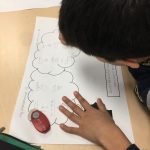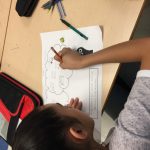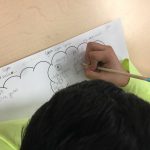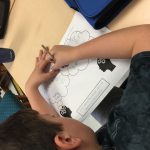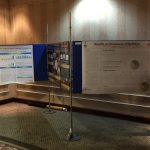In this report, what follows is our attempt to reveal our observations from the impact of the mindfulness-based activities that were implemented in our classrooms and how these affected the well-being of our small student population. Additionally and equally important, we have identified the reflective practice of the educators who were involved. We will cover the challenges and obstacles that were met and how we maneuvered around these or learned from them to gain the best possible results within a given set of parameters (i.e., classroom setting in a busy school, students of various learning styles and interests, time constraints, etc.). Finally, we were able to take key findings and current research from the conferences we attended, namely “A Mindful Society,” to ensure that our approach to teaching and learning about mindfulness is practised as accurately and efficiently as possible going forward.
Team Members
Tanmay Davé
Peel District School Board
Pilar Garcia-Yee
Peel District School Board
Xochitl Lugo
Peel District School Board
Brianne Moschella
Peel District School Board
Professional Learning Goals
- Teachers involved developed a refined and comprehensive personal mindfulness practice based on the professional resources and workshops/conferences that were attended
- We developed an understanding of mindfulness practices, and the research supporting mindfulness, meditation and self-regulation
- We modelled mindfulness practice for students including guided meditation, breathing exercises, “self-regulation” circles and yoga
- We deepened self-awareness as teachers and reflected on the impact of mindfulness in increasing the well-being of teachers and students
- We explored the effects of using the physical space of the classroom as the “third teacher” and how adding certain elements can create calm spaces and assist in focusing the mind (i.e., using the aromatherapy water diffusers and the Trichime Zen Bell)
- We learned about and taught students about the brain and how mindfulness affects the structure, performance and neural patterns in the brain
- We reflected on the connections between mindfulness and mental health, and how to support current mental health concerns amongst both staff and students through mindfulness practices
Activities and Resources
We used various written resources (i.e., books, texts, workshops, speakers, conferences, handouts, cards, journals, videos, etc.) that allowed us to inform and direct our lessons and inform our practice. These practices and activities included:
- Using the iPads and various apps such as Stop, Breathe, Think and Calm to guide students through mindful breathing and guided practice (i.e., “7 Days of Calm,” talks on anxiety/stress)
- Liaise with other Peel board staff members from both elementary and secondary panels at the “Mindfulness Network” sessions put together by the central board office
- Using release time to discuss and collaborate with our group members the action plans, goals and lessons/activities that can be implemented within our classrooms
- All group members attended a mindfulness workshop to deepen our own practice (i.e., through yoga, body scan, mindful walking, mindful eating, meditation)
- All group members attended a two-day mindfulness conference hosted by “A Mindful Society” in Toronto, Ontario
- Two group members attended an ETFO well-being conference to develop a sense of self-care and how to ensure educators/teachers sustain their own health and well-being (i.e., understanding how compassion fatigue may manifest within us, determining pathways to building more balance)
- Surveys on Google Forms given to all students that participated in this project
- Student feedback and participation through graphic organizers, journal reflections, exit cards, mindful letters to others, rating scales
- Meditation and breathing sessions with the aromatherapy diffusers on, where we often kept the aromatherapy diffusers running throughout the day as part of the classroom (i.e., changing light colours, instrumental music, water vapour)
- Gratitude journals to develop active and mindful reflection on what students are thankful for (i.e., people in their lives, skills and strengths, etc.)
- “Calm Minds and Stressed Minds” activity for students to name/draw/recognize what affects them in positive/negative ways and the emotions they evoke
- Introducing yoga to students to provide strategies of breathing, relaxing, stretching and gaining a new form of exercise/movement
- Mindful listening activities to reflect on the sounds/voices/music that was played and to build attention/focus skills (i.e., through visualization techniques, etc.)
- Mindful colouring of mandalas to assist in calming practices, and building attention and orientation to the present moment without rushing
Please see the links to the Weebly and Adobe Spark in the “Sharing” section for more details on the work done in this project.
Unexpected Challenges
Being out in the portable, at times, was difficult to find the space to be able to comfortably move our bodies during Mindful Movement and we were not able to participate in yoga in this space during the winter time. Other times, such as when the weather is warmer, teachers are bringing classes out, which entails constant activity and noise coming from the outside (i.e., balls bouncing, kids playing and running, shouting, etc.) and it is not always easy to block out the outside noises during meditation.
A dedicated space is needed for this practice, such as a room that can be accessed and is a quiet and welcoming space for all those that wish to use it or to practise (even staff).
Not having enough technology so that every student could use the specific Mindful app at the same time also posed a challenge. At times, it was frustrating not having the technology for all students to have a group session using Mindfulness and Meditation apps.
Health and Safety concerns included the challenge of not being able to use diffusers with scented oils, which have proven to have positive health effects. In addition, adding our own furniture to create a mindful space was a concern if we did not use materials that need to be approved and purchased through the board. Setting up the space in advance by moving tables aside and having students use cushions or pillows to sit on helped alleviate some of the discomfort, although a few students often complained about being physically uncomfortable.
“The best way to have mindful kids is to have mindful adults.”– Christopher Willard. Sometimes it was a challenge to engage mindfully or model mindfulness if we, ourselves, as teachers, were not in a good state that period or that specific day.
Time was one of the biggest factors in producing obstacles or challenges to our work. Within the day, because of the busy nature of school schedules, there are days when we can’t have a consistent session to really build the practice. A consistent period in the morning would be best when planning a mindfulness session with students. Arguably, this lack of time is one of the greatest challenges to implementing and building the practice of mindfulness because it takes away from one of the most important aspects: the dedication, commitment and perseverance it requires to come to fruition. Students require disciplinary thinking and need motivation as well as routine to build habits. Outside of the classroom setting, we are limited in our reach to promote mindfulness practices that require efforts in order to develop. It is, after all, an art form or skill that needs to be nurtured over time. Frequent interruptions in the school were also a concern. When practising mindful focus, announcements or other students/ teachers interrupting the classroom or practice would sometimes cause students to become distracted or inattentive and break the flow of the practice.
When talking with other teachers about mindfulness practices, we were sometimes met with different colleagues that expressed resistance to our project (which was a challenge as it helped to refine our thinking). This included conversations with educators that entailed skepticism, a perceived lack of research on mindfulness, and the notion that mindfulness is more “buzzword” and “hype” rather than substance.
Upon further reflection and through conversations of our own, we also noticed that the whole field of mindfulness and the realm in which it is developing is subject to much misinterpretation, subjectivism and perceptions, and a very real exploitation (or industrializing) of the field. Although most of the resources and literature we came across dealt in both theory and practice that was supported by credible research and work (i.e., names like Jon Kabat-Zinn, Thich Nhat Hanh, Deborah Schoeberlein David, Susan Gillis Chapman), it was interesting to note that many participants had broad and often loose views/definitions of mindful practices that made it difficult to decipher whether they were truly practising mindfulness, and ultimately what true mindfulness practices are (i.e., specific people, certain types of texts, videos, activities and practices). In simple terms, if we don’t define the parameters of what something is and how a practice such as mindfulness also has structure and form, we are at risk of including everything and ultimately losing sight of what an original definition or concept is.
To add to this, another challenge is data collection. With mindfulness, it is difficult to measure progress and how practices can benefit individuals. We often don’t know which practices are going to resonate or not and students in particular are constantly under evaluation or assessment. Anecdotal notes, self-assessment and reflection are often the best forms of measuring the success or progress of mindfulness practices, but we may not capture the true responses, results and experiences of individuals.
Enhancing Student Learning and Development
- Increased ability to assess need for quiet time for self
- Able to concentrate and focus for sustained periods of time
- Increased capacity for attention and awareness of self-regulation
- Self-monitoring and self-regulation; letting teachers know when they need to participate in a practice to feel more relaxed
- Allowing students to be more productive in the classroom
- Increased self-awareness, increased awareness of triggers (what got them anxious, nervous, upset, bothered, confused, etc.) and how to work towards calming this to be able to handle these emotions better
- Students are able to recognize how they are feeling and how to self-regulate and then have choices of how to respond
- Recognizing the need for letting go of trivial matters or prioritizing matters that students learn to be more important
- Enhanced problem-solving strategies and being present in the moment to assist students in conflict management (i.e., knowing how to reframe their thoughts, control emotions, think before they act, etc.)
- Building stronger and more positive relationships with their peers and teachers by learning mindful communication methods
- Connecting their sense of mindfulness with feelings of gratitude – connections to our Earth, our planet, building a relationship with their own mind, body, one another, environment
- Increasing attention and introspection and becoming more connected to kindness, compassion and understanding
- Use of breath – which everyone has, in the release of tension, and breathing as “the anchor”
- Mindfulness is not a tool, but a path and one that they will use as the years move forward
Sharing
- During our team meetings, we kept minutes/notes of our observations and learning and created a Google Folder and Team Share where we posted lessons, activities, graphic organizers and PowerPoint presentations, and where we compiled a list of resources/websites that could be used in our classrooms and shared with our colleagues on this project
- We convened with our administrator as the project progressed and we plan to meet with our administrator at the conclusion of the project this year to list recommendations and ideas for next year for the whole school (i.e., conveying mindfulness practice, research, activities, etc. to all staff and students)
- During Mental Health Week in May, we conducted a whole-school mindfulness session of meditation and guided practice (over the PA system) and opened up a Mindful Chalet session to all students and staff over the lunch hour
- Sample student work was also placed on walls as “posters” along with printouts/posters from other professional mindfulness documents showing the benefits of meditation and mindfulness
- Conversations and collaboration with colleagues involved in similar work around self-regulation and student mental health/well-being
- We plan on putting together a presentation/talk at the final staff meeting to share some of our practices and findings with our colleagues and administrators, as well as to initiate conversation to start off lessons/activities in September 2018
- Attend several workshops, classes over the summer and continue this practice in the new school year with students and colleagues
- Creating presentations using 21st century media (i.e., communicating our personal classroom/teaching experiences through Weebly and Adobe Spark)
One of our best forums for conveying some of the results of our work was during STEAM Night, an evening showcasing the talents and skills of students across the school from areas such as science, technology, engineering, art and math. We took the opportunity to present a number of displays across the classroom on the research as well as activities we had been conducting throughout the year. Here we showed videos on the neuroplasticity of the brain and the benefits of meditation, shared student work related to “stressed” and “calm” minds, provided activities and simple practices such as journalling, mandala colouring, breathing techniques to calm the mind, and shared resources and literature with parents. This was a great opportunity to answer questions and have conversations around the benefits of mindfulness and meditation for children and adolescents. Further, many parents were quite intrigued and shared positive feelings about the activities around mindfulness being conducted in the classroom, as well as the books and literature introducing them to the research.
Project Evaluation
Based on the impact of our work on the two groups of learners, the teachers taking part in the TLC and the students who took part in the activities, we believe our project was extremely successful. It is difficult to measure “success” in mindfulness as noted above in the category of “Unexpected Challenges,” since the success of such work requires ongoing practice and it can’t be limited to quantitative data alone. However, based on responses from students in reflective journals, self-motivated requests to perform mindful practices, and the overall reception towards a once new and unfamiliar set of ideas/activities to assist their own well-being, undoubtedly the project undertaken was a great success. The overall goals of delivering a set of strategies to students from mindful breathing to just orienting minds in order to “be present in the moment,” as well as the immense professional and research-based learning that we as educators have gained from scholars and literature in the field, are indicative of the success of this project.
For one of the classroom teachers, it was interesting to work with the Grade 8s of the homeroom classroom:
“As they were keen to explore mindfulness and meditation and regularly asked to use this practice. Once they understood the format and the forms (colouring in silence, listening to mindful music, deep breathing, body scans, mindful movement routines, walks in nature), they sought this out intrinsically and asked for it on their own. There were often times where students came into the class and stated, ‘I am anxious today, not feeling good. Can I get a mindful colouring sheet and work on this for a bit?’ With the gratitude letter in which students had to write a letter of appreciation to a classmate (randomly selected), students also had to provide written feedback to the letter and how it made them feel. Both Grade 8 classes, 52 students in total, responded positively and favourably with such words as ‘wonderful, happy, surprised, great, appreciated, cared for, etc.’ They all expressed that it was a necessary and needed activity. Many of them wrote about having a bad morning or not feeling too good or just not knowing others thought of them in this way and that it made their day, or that they were so surprised to know someone had taken notice of what they had said or done in class or in the schoolyard. I read them all, and they were heartfelt and authentic and honest.”
As teachers, we were able to focus on our own mindful practice. At the Mindful Society Conference and in the resource Mindful Teaching and Teaching Mindfulness, a message that resonated and was repeated was to be a mindful leader and that was the best way to teach and share the practice. Modelling mindfulness, being present with students, taking a deep breath and mindfully listening to students is important when teaching students how to self-regulate with these tools. In other words, practise what you preach.
As we first embarked on this journey, my own particular motivation was the need to bring about a sense of spirituality and connect students back to their own innerselves, beyond the material and everyday pursuits that we are surrounded with on a daily basis. When we were given an opportunity to pursue the project through the OTF applications, I immediately knew this task would not be considered “work” since it was already a passion of mine. Further, when we know what resonates with our own thought processes and systems of thinking, we also know who we can surround ourselves with to sustain our actions and pathways. This group of educators was without a doubt the perfect set of individuals to carry the project of mindfulness because, quite frankly, we all believed in the power of mindfulness and mindfulness-based practices.
Although at the onset of our project and meetings we found ourselves discussing what exactly the specifics of this project would entail and even questioned the very subjective definition of mindfulness, we came to realize that the breadth and scope of the field was large enough to encompass all aspects of well-being. Connecting this to the well-being of ourselves and our students and using the practices of mindfulness to influence student behaviours and performance was our biggest goal as educators. We also noticed that the fundamental step towards this goal was that we ourselves, the educators or facilitators in the classroom, have to be consistent practitioners of mindfulness and develop the mindful attitude or thinking that is essential to bringing about mindfulness in others.
As we read through the resource Mindful Teaching and Teaching Mindfulness: A Guide for Anyone Who Teaches Anything by Deborah Schoberlein David, we knew that it spoke to the experiences of so many educators because of the messages that the author communicates and how we are constantly finding ways to serve the interests of our students. We also realized that we were already doing much of what she writes about and that there were many activities that we may be able to modify. Taking note of our own students’ thinking and reflecting on our own personal states of awareness has always been and will continue to be one of the most essential messages in developing mindful thinking both in and out of the classroom setting. To quote from Deborah Schoberlein David:
“There is also a noticeable difference in students’ performance when they learn mindfully versus when they do schoolwork mindlessly. When students are really there, the classroom is alive with learning and their work shines. When they’re disengaged or distracted, well, the classroom is more likely to be dull or in chaos.” – Page 7
Another key learning from Schoberlein David’s book was that essential to student success are the grounds on which our relationships are formed. We have known for a long time that students who see themselves in their learning and whose voices are valued in the classroom are much more likely to be engaged and interested. In Happiness the Mindful Way: A Practical Guide by Ken A. Verni, we are given a very realistic and holistic sense of how to approach mindfulness. Everything from letting go of negative feelings, to being present in the present moment, to growing our understanding about our own learning is explored in detail with easy access to the language. When we share such teachings with our students in contextualized examples, they can relate, understand and benefit from knowing that their teachers care for their concerns. For example, giving students a sense of how to deal with a situation or manage, cope and face the challenge of negative thoughts or situations, is more likely to result in more success than running away. If these relationships then are based in trust, care and culturally responsive pedagogy, then our work can flourish. Thus, mindfulness in building relationships allows us to consciously invest in our students and this requires an effort on our part.
As Schoberlein David states:
“Mindfulness promotes inner awareness and outer attunement in tandem. The more easily, and accurately, you notice what’s happening mentally, emotionally, and physically within you, the less effort you need to expend paying attention to yourself. As a result, your inner awareness parlays into more energy for focusing on other people’s experiences. This occurs when people communicate with reciprocal awareness and attention, and in the classroom this means teachers and students interact in sync.” – Page 72
Resources Used
The Physical and Psychological Effects of Meditation: A Review of Contemporary Research (June 1, 1997 – Introduction – Michael Murphy, Steve Donovan and Eugene Taylor)
http://noetic.org/sites/default/files/uploads/files/Meditation_Intro.pdf
Mindful Games Activity Cards: 55 Fun Ways to Share Mindfulness with Kids and Teens by Susan Kaiser Greenland
https://www.amazon.com/Mindful-Games-Activity-Cards-Mindfulness/dp/1611804094
Mindful Teaching and Teaching Mindfulness: A Guide For Anyone Who Teaches Anything by Deborah Schoberlein David
https://www.wisdompubs.org/sites/default/files/preview/Mindful-Teaching-Preview.pdf
Buddha’s Brain: The Practical Neuroscience of Happiness, Love & Wisdom by Rick Hanson
“Effects of Mindfulness on Psychological Health: A Review of Empirical Studies” by Shian-Ling Keng, Moria J. Smoski and Clive J. Robins (May 2011)
A Mindful Society – May 2018 Conference Toronto, Ontario
Resources Created
These resources will open in your browser in a new tab, or be downloaded to your computer.



